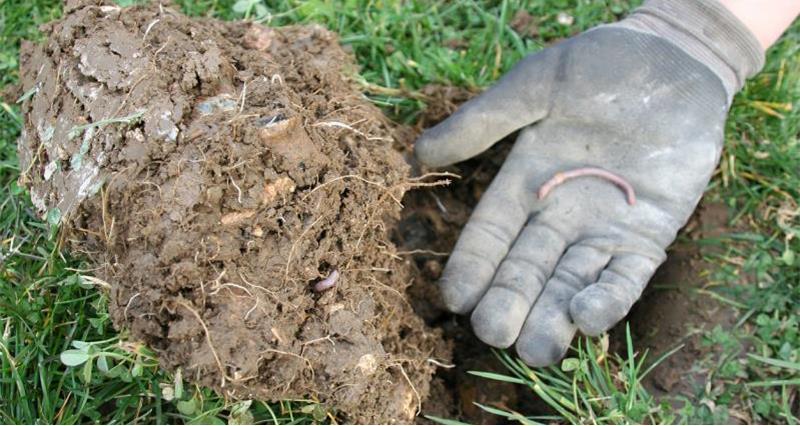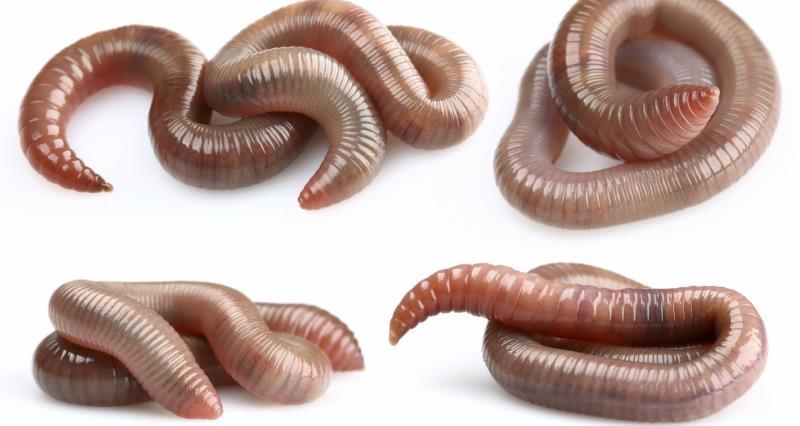To celebrate World Earthworm Day (21 October 2023), we have pulled together a top 10 of interesting earthworm facts and information.
1. How many species or types of earthworm are there in the UK?
In the UK we have 27 species, 10 of which are commonly found in agricultural soils and these can be grouped into three ecological types:
- Surface dwelling earthworms (Epigeic earthworms) don’t make burrows but live on the surface of the soil – often in leaf litter and in compost. They rapidly consume the compost material and reproduce very quickly. They are usually bright red or reddish-brown, and the compost worms in particular (known as brandling or tiger worms) are often stripy.
- Shallow burrowing or topsoil earthworms (Endogeic earthworms) are pale coloured – pink, grey, green or blue – and make horizontalÌýburrows through the soil to move around and to feed. Some can burrow very deeply in the soil.
- Deep burrowing earthworms (Anecic earthworms) are the most common earthworms in the UK. They are the largest species, often reddish brown, and they make permanentÌýverticalÌýburrows in soil. They feed on leaves on the soil surface that they drag into their burrows. They also cast on the surface, as often seen in grass. They make middens (piles of casts) around the entrance to their burrows.
2. What is an earthworm’s role in improving soil health?
Earthworms can improve soil structure as their burrows are used by crop roots (to reach extra moisture and nutrients) and worm casts can cement soil particles together to form aggregates. Burrow walls, worm casts and middens contain concentrated plant available nutrients such as Nitrogen and Sulphur, increasing plant nutrient availability and their deep vertical burrows particularly help water infiltrate.
Additionally, their role in decomposing organic matter helps to stimulate the soil microbial community. All of this helps to improve plant productivity.
3. How can you tell an adult earthworm from a juvenile earthworm?
[Lottie to reword]
4. How can you tell a female from a male earthworm?
You can’t tell the difference. Earthworms have both male and female reproductive organs (hermaphrodite), although they still need to find a mate to reproduce.
5. What do earthworms eat?
An earthworm’s diet consists of decaying organic matter, such as leaf litter or crop residue. An earthworm’s digestive system runs through the length of its body. Earthworms themselves, are an important source of food for plenty of creatures, including hedgehogs, foxes, moles, many birds, slow worms and amphibians.
Ìý
6. Will an earthworm survive if it dries out?
Earthworms conducts respiration through its skin. Their skin needs to be moist in order to breathe, so if an earthworm dries out, it will die. Within the soil the earthworms form a mucus–lined chamber, in which they curl into a tight ball in order to prevent moisture loss. They remain in these chambers until more favourable soil conditions prevail.
7. Why are earthworms slimy?
They may feel slimy to the touch, but they are actually covered in tiny, hair-like bristles called setae. Each one of the body segments, called annuli, use their setae to help the worm move through the dirt. Without these bristles,ÌýearthwormsÌýwould find it much more difficult to burrow underground.
8. Why are they referred to as ‘ecosystem engineers’?
As Darwin wrote ‘There are few animals which have played so important a part in the history of the world than the earthworm.’
They are a natural way to maintaining soil structure and fertility as they aerate the soil, improve drainage and bring nutrients to the surface. These actions help support the ecosystem services that soil provides.

9. If you cut an earthworm in half, does it make two?
It is a common misconception that if you cut an earthworm in half it makes two new worms. Although they can regenerate to a small degree, usually both halves die.
10. How can I learn more about earthworms in my soil?
If you would like to find out more about the benefits of earthworms in agriculture, find out how to sample them or improve their population numbers the following information may be of interest;
- AHDB’s fact sheet;
